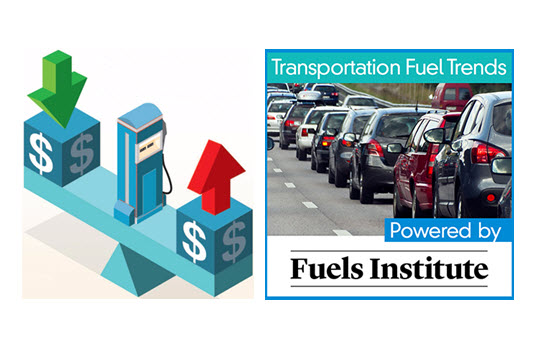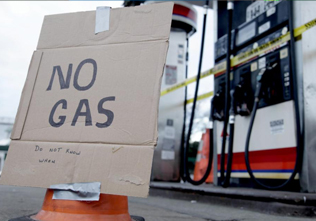Have you ever watched kids playing on a teeter-totter? Who is having more fun—the kid going up or the one going down? Or perhaps more importantly, which kid has greater influence over up vs down? I suggest you could ask the same thing about the oil market—who likes prices going down, who likes them going up and what is having the greatest influence on the movement?
Let’s set the stage – consumers love cheap gas. More than three years of monthly consumer surveys conducted by NACS confirm this—with minimal variation—when prices go down, overall optimism about the nation’s economy goes up and vice versa. At the same time, fuel retailers love cheap gas. Typically, margins are stronger, costs are lower and consumers have more money to spend inside the store. So, these groups want to be on the side of the teeter-totter that is going down.
We also know that when fuel prices are low, consumers are less sensitive. While price remains their number one reason for selecting a fuel retailer, its intensity is much lower than when prices are high. Consequently, consumers don’t shop around for the lowest price with as much dedication, they are not seeking every opportunity to reduce fuel consumption and they are not intensely considering more fuel efficient or alternative fuel vehicles. The impact? Interest in alternative fuels and vehicles wanes.
Those advocating the adoption of alternative fuel, or simply more efficient vehicles prefer it when the teeter totter is up—higher gas prices increase interest in, if not the purchase of, these vehicles. The empirical evidence indicating consumers swapping their preferred class of vehicle in response to volatile pump prices is murky (i.e., Bubba ain’t trading his full size pick-up for a compact sedan and the family with four kids is not ditching their SUV for a two-door coupe), but the adoption of alternative powertrains does seem to flutter with fuel prices.
Let’s use hybrid vehicles as a case study. Since 2013, the retail price of gasoline has dropped from an annual average of $3.49 to $2.13 in 2016. Meanwhile sales of hybrids have dropped 32% and their share of light duty vehicle sales has dropped 40%. This is not a declaration that fuel prices drive the type of vehicles consumers buy – that is way too simplistic. But, it is an indication that consumers are not as easily able to justify paying the additional price for a hybrid vehicle when fuel prices are low – the return on investment takes a lot longer and they simply don’t have a daily reminder to encourage them to do the calculations.
When the retail price of gasoline eclipsed a national average of $4.00 per gallon in 2007, there was tremendous enthusiasm in alternative powertrains and fuels, and investments in research and development flourished as companies raced to satisfy the needs of the frustrated consumer. Now, it seems like you can hit the consumer on the head with a 2×4 and they may not even blink. They are having too much fun riding the teeter-totter down. But if that teeter starts to totter up again, will they start to look around for cost-saving alternatives? And will those alternatives be available and affordable? A lot depends on how long fuel prices stay low, because that impacts how long automobile manufacturers can and will produce products that consumers are not looking for. Particularly in the absence of government mandates, who knows how sustainable it is?
When we start to talk about the government, the dynamics of this old school playground metaphor get interesting.
Let’s focus on oil, which is the primary force affecting the direction of the teeter-totter. It represents on average more than 60% of the retail price of gasoline. So, when oil prices go up, the teeter-totter goes with them. But what is influencing the direction of movement? The oil market is incredibly diverse with too many players and influencing factors to really develop a comprehensive overview in such a small space. So, let’s isolate and focus on one critical factor—U.S. policy.
Working to push the teeter-totter side down are administration policies affecting domestic oil production. Supporting Keystone and Dakota Access Pipeline projects, opening offshore oil production and expanding domestic energy production puts the U.S. into a position to have a growing influence on global markets. Increased domestic production can put downward pressure on increasing global prices, especially now that the U.S. is exporting oil into the global market.
However, working to prop the teeter-totter up are those who do not like low oil prices. OPEC is working to cut production in an effort to drive prices higher and several non-OPEC nations have been cooperating with them. Their economies depend on higher oil prices, and perhaps none more so than Russia. And when Russia needs something that the global market seems disinclined to provide, its neighbors start getting nervous (but that is another story).
Enter into the equation an unlikely potential ally of those seeking higher oil prices—U.S. foreign policy.
The price of oil is determined primarily by traders on Wall Street buying and selling futures contracts. These prices are based upon actual and anticipated changes in supply and demand. We have learned that military conflicts in the Persian Gulf region lead to increased volatility in the markets. If more assertive policy initiatives of the U.S. lead to increased tension in oil producing regions of the world (or prompt a more assertive foreign policy by Russia), it is conceivable that this tension would exert upward pressure on oil markets.
So, which kid – domestic policy or foreign policy— is heavier? The answer is not immediately clear, but whichever way the oil market teeters or totters, retail gasoline prices will ultimately follow.
This playground metaphor, while perhaps antiquated, is real—if global unrest yields higher oil prices, the incentive for domestic production increases. The introduction of more North American oil into the global market could yield lower oil prices, with the net effect being relative stability in the fuels market. Who wins?
If the two forces acting on the teeter-totter are equal, the consumer will prevail and continue to enjoy relatively low fuel prices. It is conceivable that U.S. production can be increased sufficiently to offset upward price pressure exerted by global tensions, thereby limiting the upward potential of the oil market and protecting consumers from a significant run up in price. (Unless other domestic policies, such as protective trade measures, exerts upward pressure on the market.) In a market that might be stable at current prices, consumers will remain happy and non-fuel spending should stay strong.
By contrast, in a stable market alternative fuels and technologies will struggle if they do not improve their value proposition to convince consumers to make the switch. This dynamic is likely to slow their pace of market penetration but will ultimately make them better and more competitive. Once again, this could yield significant consumer benefits. Once alternative powertrains are competitive with traditional vehicles, they will be able to compete on their merits rather than relying upon the fickle fuel market for survival.
On the playground, it really doesn’t matter which way the teeter totters—both kids have fun. Maybe in this metaphor, the consumers are the kids and, if neither of the competing forces in the oil market gain a significant advantage, the consumer could reap the benefits. Only time will tell which carries more influence – domestic or foreign policy.
SOURCE - fuelmarketernews.com







